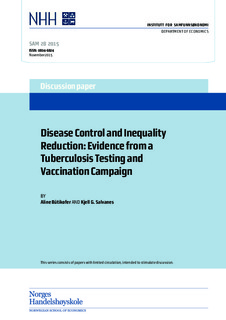| dc.contributor.author | Bütikofer, Aline | |
| dc.contributor.author | Salvanes, Kjell G. | |
| dc.date.accessioned | 2015-12-02T14:51:03Z | |
| dc.date.issued | 2015-12-02T14:51:03Z | |
| dc.identifier.uri | http://hdl.handle.net/11250/2366588 | |
| dc.description.abstract | This paper examines the economic impact of a tuberculosis control program launched in Norway in 1948. In the 1940s, Norway had one of the highest tuberculosis infection rates in Europe, affecting about 85 percent of the inhabitants. To lower the disease burden, the Norwegian government launched a large-scale tuberculosis testing and vaccination campaign that substantially reduced tuberculosis infection rates among children. We find that cohorts in school during and after the campaign in municipalities with high tuberculosis prevalence gained more in terms of education, income, and longevity following this public health intervention. The results also suggest that individuals from a low socioeconomic background benefited more from
the intervention. Hence, we present new evidence that a narrowing of the gap in childhood health can lead to a reduction in socioeconomic inequalities in adulthood. | nb_NO |
| dc.language.iso | eng | nb_NO |
| dc.relation.ispartofseries | SAM;28/2015 | |
| dc.title | Disease Control and Inequality Reduction: Evidence from a Tuberculosis Testing and Vaccination Campaign | nb_NO |
| dc.type | Working paper | nb_NO |
| dc.subject.nsi | VDP::Social science: 200::Education: 280 | nb_NO |
| dc.subject.nsi | VDP::Social science: 200::Economics: 210 | nb_NO |
| dc.source.pagenumber | 48 | nb_NO |
